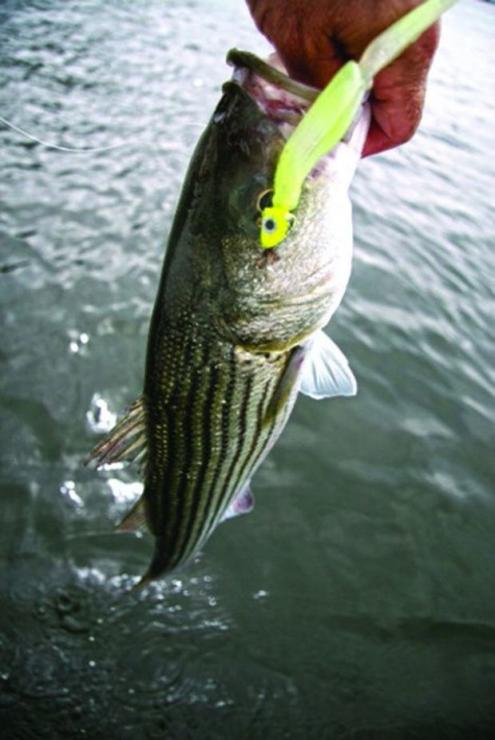 When you hear “fall blitz,”
When you hear “fall blitz,” do you A) think of the world champion Baltimore Raven’s defense;
B) recall that horrendous, pseudo-glam rock anthem “Ballroom Blitz” by the one-hit-wonder The Sweet (yeah, exactly: who?!); or C) get the urge to cast lures on light tackle into a piscatorial melee?
Hopefully you answered “C,” although picking “A” is understandable. If you chose “B,” however, you may fall into the ‘strange ranger’ category. (Lest you ridicule me for creating such a question, “C” was a trick question!) So the only surefire way to cleanse your hippocampus of such an oddball memory is to persuade (or beg) one of your buddies who does fish (and correctly picked “C”) to let you tag along when the blues and rockfish churn the Chesapeake waters into a frothy mix as they chase baitfish. No friends? Book a trip with one of PropTalk’s professional fishermen, and you’ll soon have some. Whatever you do don’t miss out on the next couple weeks of fishing.
Know Your Birds & Bait
Most anglers know a drop in water temperature will incite more active feeding by gamefish. As summer yields to autumn, the days also grow shorter. This reduction in the photoperiod--for purposes of this article: the amount of sunlight fish are exposed to within a 24-hour span--triggers an urgency within predators such as rockfish and bluefish to feed more aggressively.
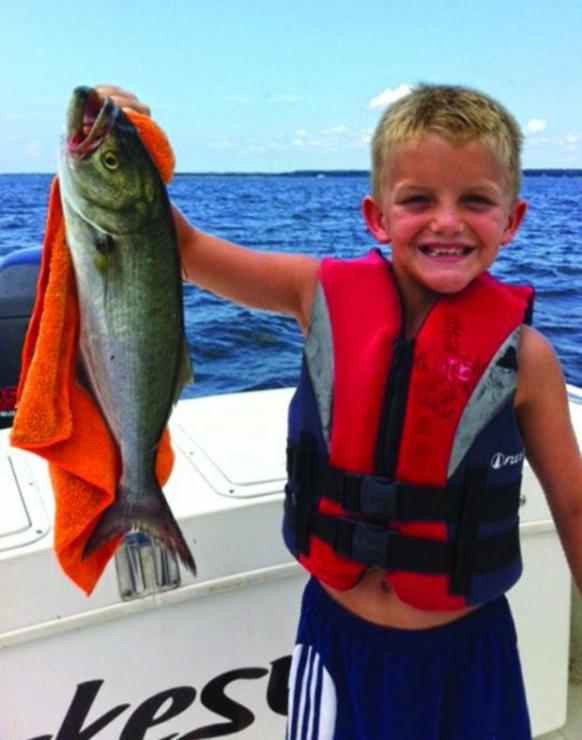
Also at this time of the year millions of baitfish move out of the sheltered tributaries into more open waters, where they’re forced to seek safety in numbers; e.g. schooling. And it’s the convergence of these two events that spawns the frenetic fall fishing we love so much in the Chesapeake. Typically it involves bluefish and rockfish losing their minds in hot pursuit of baitfish, either silversides or bay anchovies (sometimes called rainfish, an interchangeable term for both) or juvenile menhaden, aka bunker.
Sometimes it matters very little what kind of lure you troll or jig, the color, shape, etc. Once an old timer told me blitzing bluefish would hit a Budweiser pull tab and, apparently not liking either my non-reply or the cut of my jib tied, or both, tied one on (to the end of his line, not a bender) and proved his point.
Yet, there are occasions when gamefish do key into a specific bait even during a frenzy. So if your offering isn’t a close facsimile of what they want, you might be out of luck. In other words, it pays to know your prey species. Another good rule of thumb when sport fishing is to look for signs of life, and while diving birds are definitely a sign of fish feeding, pay attention to other, less obvious things such as fishy smell or sheen on the water’s surface. Some of the best fishermen I know are competent, amateur naturalists.
Also, remember that the size and kind of bird wheeling over a patch of water can tell you if you’re on big fish or just the little fellas. Typically, the bigger birds (pelicans, gannets, black-back gulls) feed on the bigger the bait. And bigger bait often attracts bigger rockfish. The opposite can also be true, though remember there are rarely absolutes in fishing. Fishermen sometimes call terns and smaller gulls “liar birds” because while they seem to be tipping you off to a score, many times it’s smaller fish and occasionally no gamesters at all, just bait. I’m not suggesting you blow by a school of breaking fish over which small gulls hover; getting the skunk off the boat is always a relief. Just bear in mind that if you want bigger fish, look for larger birds.
And do not overlook the presence of loons, especially if there are several diving. These birds are expert fishers, so it may be that they’re feeding on the same bunker school that a nice pod of rockfish is gorging on, albeit lower in the water column. I’ve had one of my best days jigging with just me, two other guys and half a dozen loons. We worked a pod of rockfish to 35” and blues to six pounds between Poplar Island and Wades Point for 90 minutes, and not a single bird dove into the action.
You should continuously scan the horizon with quality binoculars to look for the action. Some experienced skippers use their radar to pick up flocks of birds, a practice more common in the open waters of the southern bay or in the ocean where the size of the flocks are large enough to get picked up.
Go Slow, Joe!
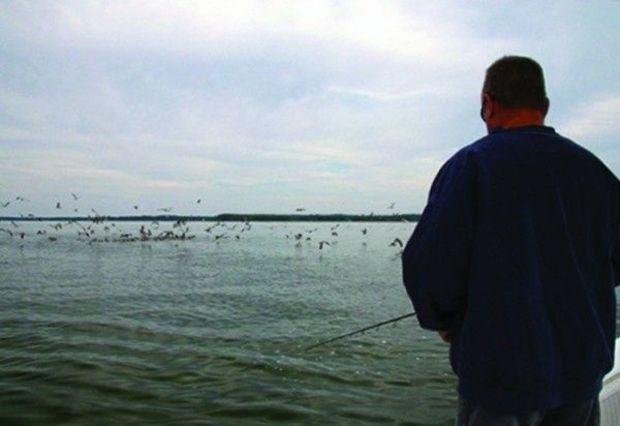
Before we get to methods and lures, a few paragraphs about approaching a school of breaking fish. If you’re an old salt to the sport then perhaps you’ve seen this scenario: a handful of boats jigging over a school of mid-20” rock, catching fish cast after cast. Life is good. Very good.
Then from beyond the horizon comes Bubba, damn the torpedoes. He skids to a stop in the middle of what was once a hot bite, grabs his rod, chucks the lure into what 60 seconds earlier had been a fish scrum. He then shrugs his shoulders when no fish comes tight to his line, and throttles off the next “hot spot” which he undoubtedly douses tout de suite with his insufferable angling acumen.
Perhaps we’re a more polite, or litigiously averse, set of fishermen these days, but there was a time when such boorish manners would bring a sinker upside the offender’s gelcoat. If you see boats and birds working a school, approach the action from up tide at an idle. Better yet, check your exuberance and watch the action. See which way fish are moving. Motor slowly around the school, looking at your fishfinder for larger fish that may be hanging down-tide of the central fracas. Bottom line is be courteous and wait your turn. And same goes for you trollers. Running right through the school is rude, and only proves your boat is bigger.
Get Jiggin’ With It
Several PropTalk contributors (see Fishing Forecast) think we might be in for stellar fall fishing due to the fact that there are lots of resident (schoolie) stripers around. As long as it doesn’t get too cold too fast, we can also expect to catch bluefish and perhaps the season’s last Spanish mackerel, too, this month. A few redfish hanging around the bait schools is certainly not out of the question, though they prefer shorelines.
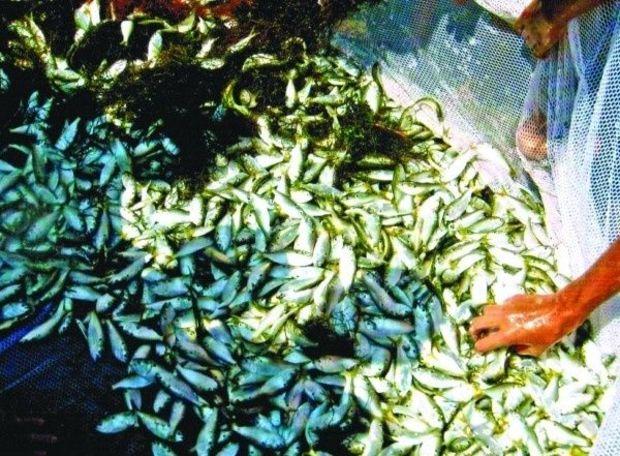
So should you fish soft plastics or metal lures? Yes, and yes. When snapper blues and stripers mix together, I prefer using metal jigs. Bluefish (and macks) are slasher style predators, ripping at their prey. Thus, they make short work of soft plastics. I like Crippled Herring and Lil’ Bunkers (3/4 to 2 oz., silver and chartreuse), but there are lots of fish catchers out there.
For rockfish holding deeper in the water column, soft plastics are a great choice. I use a leaded jig of 3/4 to 2 ounces and tip it with a BKD, Bust ‘Em Baits or Bass Assassin. Again, other good choices abound, such as Money Minnows, Gulp! or Hogeys. In my book, it’s better to learn to properly work a few jigs than have 10 different kinds in your tackle kit.
On the edges of the schools I love throwing a topwater plug. I can’t prove it, but I think some of the true badass fish cruise the outskirts. At least they hit like it. I like Bombers, Zara Spooks and Smack-its. Almost always I tinker with the lures. It doesn’t catch me any more fish, rather the opposite. But seems to lessen the impact on fish. I usually clip off at least one of the factory trebles or replace it outright with a wide-gap barbless hook. Mashed barbs and single hooks makes it a lot easier to release fish more quickly, and reduces hook injury to the rockfish and blues you don’t intend to eat. Also, if you happen to accidently foul hook a gull, a lone hook is a heck of lot easier to remove. (Note: if you haven’t inadvertently snagged a gull, you’re either a liar or don’t fish a bay frenzy nearly often enough. See “running aground” axiom.)
In recent years, I’ve gone to tying on a streamer fly to the poppers tail. I like a 18” shot of 40- or 60-pound fluorocarbon. I recently picked up a nice tip from Joe Capp of Shore Tackle & Custom Rods in Grasonville: although he prefers heavier pound test (80#), he crimps the connection between streamer and popper. It makes for a nice, clean connection.
With a little luck in the weather department, (and we’re due, aren’t we?) the fall blitz is shaping up to be a helluva good time.
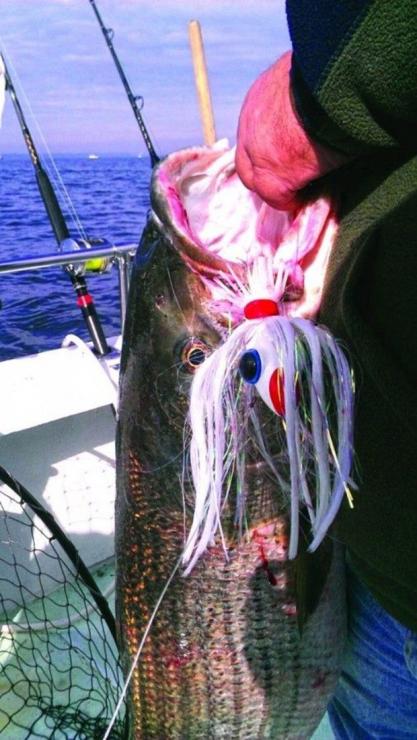
 When you hear “fall blitz,” do you A) think of the world champion Baltimore Raven’s defense;
B) recall that horrendous, pseudo-glam rock anthem “Ballroom Blitz” by the one-hit-wonder The Sweet (yeah, exactly: who?!); or C) get the urge to cast lures on light tackle into a piscatorial melee?
Hopefully you answered “C,” although picking “A” is understandable. If you chose “B,” however, you may fall into the ‘strange ranger’ category. (Lest you ridicule me for creating such a question, “C” was a trick question!) So the only surefire way to cleanse your hippocampus of such an oddball memory is to persuade (or beg) one of your buddies who does fish (and correctly picked “C”) to let you tag along when the blues and rockfish churn the Chesapeake waters into a frothy mix as they chase baitfish. No friends? Book a trip with one of PropTalk’s professional fishermen, and you’ll soon have some. Whatever you do don’t miss out on the next couple weeks of fishing.
Know Your Birds & Bait
Most anglers know a drop in water temperature will incite more active feeding by gamefish. As summer yields to autumn, the days also grow shorter. This reduction in the photoperiod--for purposes of this article: the amount of sunlight fish are exposed to within a 24-hour span--triggers an urgency within predators such as rockfish and bluefish to feed more aggressively.
When you hear “fall blitz,” do you A) think of the world champion Baltimore Raven’s defense;
B) recall that horrendous, pseudo-glam rock anthem “Ballroom Blitz” by the one-hit-wonder The Sweet (yeah, exactly: who?!); or C) get the urge to cast lures on light tackle into a piscatorial melee?
Hopefully you answered “C,” although picking “A” is understandable. If you chose “B,” however, you may fall into the ‘strange ranger’ category. (Lest you ridicule me for creating such a question, “C” was a trick question!) So the only surefire way to cleanse your hippocampus of such an oddball memory is to persuade (or beg) one of your buddies who does fish (and correctly picked “C”) to let you tag along when the blues and rockfish churn the Chesapeake waters into a frothy mix as they chase baitfish. No friends? Book a trip with one of PropTalk’s professional fishermen, and you’ll soon have some. Whatever you do don’t miss out on the next couple weeks of fishing.
Know Your Birds & Bait
Most anglers know a drop in water temperature will incite more active feeding by gamefish. As summer yields to autumn, the days also grow shorter. This reduction in the photoperiod--for purposes of this article: the amount of sunlight fish are exposed to within a 24-hour span--triggers an urgency within predators such as rockfish and bluefish to feed more aggressively.
 Also at this time of the year millions of baitfish move out of the sheltered tributaries into more open waters, where they’re forced to seek safety in numbers; e.g. schooling. And it’s the convergence of these two events that spawns the frenetic fall fishing we love so much in the Chesapeake. Typically it involves bluefish and rockfish losing their minds in hot pursuit of baitfish, either silversides or bay anchovies (sometimes called rainfish, an interchangeable term for both) or juvenile menhaden, aka bunker.
Sometimes it matters very little what kind of lure you troll or jig, the color, shape, etc. Once an old timer told me blitzing bluefish would hit a Budweiser pull tab and, apparently not liking either my non-reply or the cut of my jib tied, or both, tied one on (to the end of his line, not a bender) and proved his point.
Yet, there are occasions when gamefish do key into a specific bait even during a frenzy. So if your offering isn’t a close facsimile of what they want, you might be out of luck. In other words, it pays to know your prey species. Another good rule of thumb when sport fishing is to look for signs of life, and while diving birds are definitely a sign of fish feeding, pay attention to other, less obvious things such as fishy smell or sheen on the water’s surface. Some of the best fishermen I know are competent, amateur naturalists.
Also, remember that the size and kind of bird wheeling over a patch of water can tell you if you’re on big fish or just the little fellas. Typically, the bigger birds (pelicans, gannets, black-back gulls) feed on the bigger the bait. And bigger bait often attracts bigger rockfish. The opposite can also be true, though remember there are rarely absolutes in fishing. Fishermen sometimes call terns and smaller gulls “liar birds” because while they seem to be tipping you off to a score, many times it’s smaller fish and occasionally no gamesters at all, just bait. I’m not suggesting you blow by a school of breaking fish over which small gulls hover; getting the skunk off the boat is always a relief. Just bear in mind that if you want bigger fish, look for larger birds.
And do not overlook the presence of loons, especially if there are several diving. These birds are expert fishers, so it may be that they’re feeding on the same bunker school that a nice pod of rockfish is gorging on, albeit lower in the water column. I’ve had one of my best days jigging with just me, two other guys and half a dozen loons. We worked a pod of rockfish to 35” and blues to six pounds between Poplar Island and Wades Point for 90 minutes, and not a single bird dove into the action.
You should continuously scan the horizon with quality binoculars to look for the action. Some experienced skippers use their radar to pick up flocks of birds, a practice more common in the open waters of the southern bay or in the ocean where the size of the flocks are large enough to get picked up.
Go Slow, Joe!
Also at this time of the year millions of baitfish move out of the sheltered tributaries into more open waters, where they’re forced to seek safety in numbers; e.g. schooling. And it’s the convergence of these two events that spawns the frenetic fall fishing we love so much in the Chesapeake. Typically it involves bluefish and rockfish losing their minds in hot pursuit of baitfish, either silversides or bay anchovies (sometimes called rainfish, an interchangeable term for both) or juvenile menhaden, aka bunker.
Sometimes it matters very little what kind of lure you troll or jig, the color, shape, etc. Once an old timer told me blitzing bluefish would hit a Budweiser pull tab and, apparently not liking either my non-reply or the cut of my jib tied, or both, tied one on (to the end of his line, not a bender) and proved his point.
Yet, there are occasions when gamefish do key into a specific bait even during a frenzy. So if your offering isn’t a close facsimile of what they want, you might be out of luck. In other words, it pays to know your prey species. Another good rule of thumb when sport fishing is to look for signs of life, and while diving birds are definitely a sign of fish feeding, pay attention to other, less obvious things such as fishy smell or sheen on the water’s surface. Some of the best fishermen I know are competent, amateur naturalists.
Also, remember that the size and kind of bird wheeling over a patch of water can tell you if you’re on big fish or just the little fellas. Typically, the bigger birds (pelicans, gannets, black-back gulls) feed on the bigger the bait. And bigger bait often attracts bigger rockfish. The opposite can also be true, though remember there are rarely absolutes in fishing. Fishermen sometimes call terns and smaller gulls “liar birds” because while they seem to be tipping you off to a score, many times it’s smaller fish and occasionally no gamesters at all, just bait. I’m not suggesting you blow by a school of breaking fish over which small gulls hover; getting the skunk off the boat is always a relief. Just bear in mind that if you want bigger fish, look for larger birds.
And do not overlook the presence of loons, especially if there are several diving. These birds are expert fishers, so it may be that they’re feeding on the same bunker school that a nice pod of rockfish is gorging on, albeit lower in the water column. I’ve had one of my best days jigging with just me, two other guys and half a dozen loons. We worked a pod of rockfish to 35” and blues to six pounds between Poplar Island and Wades Point for 90 minutes, and not a single bird dove into the action.
You should continuously scan the horizon with quality binoculars to look for the action. Some experienced skippers use their radar to pick up flocks of birds, a practice more common in the open waters of the southern bay or in the ocean where the size of the flocks are large enough to get picked up.
Go Slow, Joe!
 Before we get to methods and lures, a few paragraphs about approaching a school of breaking fish. If you’re an old salt to the sport then perhaps you’ve seen this scenario: a handful of boats jigging over a school of mid-20” rock, catching fish cast after cast. Life is good. Very good.
Then from beyond the horizon comes Bubba, damn the torpedoes. He skids to a stop in the middle of what was once a hot bite, grabs his rod, chucks the lure into what 60 seconds earlier had been a fish scrum. He then shrugs his shoulders when no fish comes tight to his line, and throttles off the next “hot spot” which he undoubtedly douses tout de suite with his insufferable angling acumen.
Perhaps we’re a more polite, or litigiously averse, set of fishermen these days, but there was a time when such boorish manners would bring a sinker upside the offender’s gelcoat. If you see boats and birds working a school, approach the action from up tide at an idle. Better yet, check your exuberance and watch the action. See which way fish are moving. Motor slowly around the school, looking at your fishfinder for larger fish that may be hanging down-tide of the central fracas. Bottom line is be courteous and wait your turn. And same goes for you trollers. Running right through the school is rude, and only proves your boat is bigger.
Get Jiggin’ With It
Several PropTalk contributors (see Fishing Forecast) think we might be in for stellar fall fishing due to the fact that there are lots of resident (schoolie) stripers around. As long as it doesn’t get too cold too fast, we can also expect to catch bluefish and perhaps the season’s last Spanish mackerel, too, this month. A few redfish hanging around the bait schools is certainly not out of the question, though they prefer shorelines.
Before we get to methods and lures, a few paragraphs about approaching a school of breaking fish. If you’re an old salt to the sport then perhaps you’ve seen this scenario: a handful of boats jigging over a school of mid-20” rock, catching fish cast after cast. Life is good. Very good.
Then from beyond the horizon comes Bubba, damn the torpedoes. He skids to a stop in the middle of what was once a hot bite, grabs his rod, chucks the lure into what 60 seconds earlier had been a fish scrum. He then shrugs his shoulders when no fish comes tight to his line, and throttles off the next “hot spot” which he undoubtedly douses tout de suite with his insufferable angling acumen.
Perhaps we’re a more polite, or litigiously averse, set of fishermen these days, but there was a time when such boorish manners would bring a sinker upside the offender’s gelcoat. If you see boats and birds working a school, approach the action from up tide at an idle. Better yet, check your exuberance and watch the action. See which way fish are moving. Motor slowly around the school, looking at your fishfinder for larger fish that may be hanging down-tide of the central fracas. Bottom line is be courteous and wait your turn. And same goes for you trollers. Running right through the school is rude, and only proves your boat is bigger.
Get Jiggin’ With It
Several PropTalk contributors (see Fishing Forecast) think we might be in for stellar fall fishing due to the fact that there are lots of resident (schoolie) stripers around. As long as it doesn’t get too cold too fast, we can also expect to catch bluefish and perhaps the season’s last Spanish mackerel, too, this month. A few redfish hanging around the bait schools is certainly not out of the question, though they prefer shorelines.
 So should you fish soft plastics or metal lures? Yes, and yes. When snapper blues and stripers mix together, I prefer using metal jigs. Bluefish (and macks) are slasher style predators, ripping at their prey. Thus, they make short work of soft plastics. I like Crippled Herring and Lil’ Bunkers (3/4 to 2 oz., silver and chartreuse), but there are lots of fish catchers out there.
For rockfish holding deeper in the water column, soft plastics are a great choice. I use a leaded jig of 3/4 to 2 ounces and tip it with a BKD, Bust ‘Em Baits or Bass Assassin. Again, other good choices abound, such as Money Minnows, Gulp! or Hogeys. In my book, it’s better to learn to properly work a few jigs than have 10 different kinds in your tackle kit.
On the edges of the schools I love throwing a topwater plug. I can’t prove it, but I think some of the true badass fish cruise the outskirts. At least they hit like it. I like Bombers, Zara Spooks and Smack-its. Almost always I tinker with the lures. It doesn’t catch me any more fish, rather the opposite. But seems to lessen the impact on fish. I usually clip off at least one of the factory trebles or replace it outright with a wide-gap barbless hook. Mashed barbs and single hooks makes it a lot easier to release fish more quickly, and reduces hook injury to the rockfish and blues you don’t intend to eat. Also, if you happen to accidently foul hook a gull, a lone hook is a heck of lot easier to remove. (Note: if you haven’t inadvertently snagged a gull, you’re either a liar or don’t fish a bay frenzy nearly often enough. See “running aground” axiom.)
In recent years, I’ve gone to tying on a streamer fly to the poppers tail. I like a 18” shot of 40- or 60-pound fluorocarbon. I recently picked up a nice tip from Joe Capp of Shore Tackle & Custom Rods in Grasonville: although he prefers heavier pound test (80#), he crimps the connection between streamer and popper. It makes for a nice, clean connection.
With a little luck in the weather department, (and we’re due, aren’t we?) the fall blitz is shaping up to be a helluva good time.
So should you fish soft plastics or metal lures? Yes, and yes. When snapper blues and stripers mix together, I prefer using metal jigs. Bluefish (and macks) are slasher style predators, ripping at their prey. Thus, they make short work of soft plastics. I like Crippled Herring and Lil’ Bunkers (3/4 to 2 oz., silver and chartreuse), but there are lots of fish catchers out there.
For rockfish holding deeper in the water column, soft plastics are a great choice. I use a leaded jig of 3/4 to 2 ounces and tip it with a BKD, Bust ‘Em Baits or Bass Assassin. Again, other good choices abound, such as Money Minnows, Gulp! or Hogeys. In my book, it’s better to learn to properly work a few jigs than have 10 different kinds in your tackle kit.
On the edges of the schools I love throwing a topwater plug. I can’t prove it, but I think some of the true badass fish cruise the outskirts. At least they hit like it. I like Bombers, Zara Spooks and Smack-its. Almost always I tinker with the lures. It doesn’t catch me any more fish, rather the opposite. But seems to lessen the impact on fish. I usually clip off at least one of the factory trebles or replace it outright with a wide-gap barbless hook. Mashed barbs and single hooks makes it a lot easier to release fish more quickly, and reduces hook injury to the rockfish and blues you don’t intend to eat. Also, if you happen to accidently foul hook a gull, a lone hook is a heck of lot easier to remove. (Note: if you haven’t inadvertently snagged a gull, you’re either a liar or don’t fish a bay frenzy nearly often enough. See “running aground” axiom.)
In recent years, I’ve gone to tying on a streamer fly to the poppers tail. I like a 18” shot of 40- or 60-pound fluorocarbon. I recently picked up a nice tip from Joe Capp of Shore Tackle & Custom Rods in Grasonville: although he prefers heavier pound test (80#), he crimps the connection between streamer and popper. It makes for a nice, clean connection.
With a little luck in the weather department, (and we’re due, aren’t we?) the fall blitz is shaping up to be a helluva good time.
